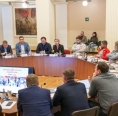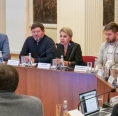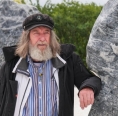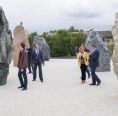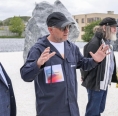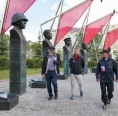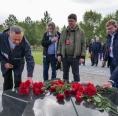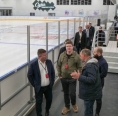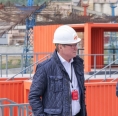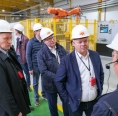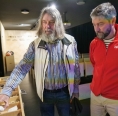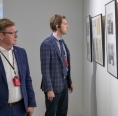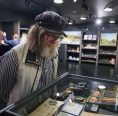-
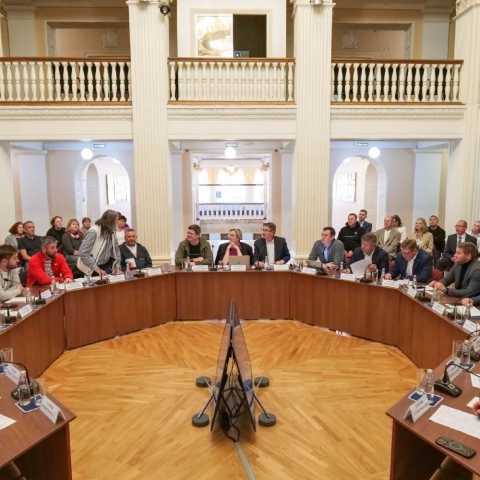
SATKA ART TOWN
On June 22, Fyodor Konyukhov, famous Russian voyager; Oskar Konyukhov, his son and head of the expeditionary headquarters; Aleksandr Bogashov, Anatoliy Vekshin, Stanislav Mosharov, Deputy Governors of the Chelyabinsk Oblast; Aleksey Betekhtin, Minister of Culture in the region; Aleksandr Vagner, rector of the South Ural State University; Alisa Prudnikova, commissar and artistic director of the Ural Industrial Biennial of Contemporary Art, as well as representatives of the Government, Legislative Assembly and the Center for Project Development of the Chelyabinsk Oblast Territories and Tourism paid a working visit to Satka.
The guests took guided tours around the town and the Satka production site of Magnezit Group (visited the Russian Magnezit tourist route) and visited the corporate museum. They participated in the Memorial and Mourning Day arrangements and laid flowers at the memorials and busts of the Soviet Union Heroes in the Slavy Square.
“It is my first visit to Satka. The town has become a true revelation and wonder,” said Fyodor Konyukhov. “It is a place where one can express oneself and a vast space for inspiration exists. As an artist, I wanted to show my art here – my works created in the ocean, at mountain slopes... And as a voyager, it came as a surprise, how I never came here for rafting, or a trip on raft or baidarka... Satka is located in a very fortunate, beautiful place inhabited by good people, true romantics. Looking at this clean, well-tended town, I understand that its citizens are culturally and spiritually educated people who love this place and develop it.”
By the way, the day ended specifically with discussion of the town and region development. The round table “Why Satka is an art town?” was held in the Magnezit community center. It was attended by the guests, the heads of the municipality and the Magnezit Group.
Elena Subbotina, Deputy Director of the fund for the promotion of development of the Satka Region, head of the public art space “Art-Satka”, told the guests about Satka as an art town. She noted that Satka’s art story began more than 10 years ago – in 2011, when the World Without Borders forum and the World Creators contemporary art exhibition were held.
“Even now, many events are arranged to further develop the cultural life of the town. Among such is the adopted strategy for social and cultural development of the region under which Satka has already became the site for multiple celebrations of the Day of the World Culture, joint implementation of projects with the Russian Historical Society, the Russian Academy of Education, the State Russian Museum, the Multimedia Art Museum in Moscow, the State Institute of Theatrical Arts, the Moscow State Stroganov Academy of Design and Applied Arts, the Higher School of Economics, and became the permanent residence of the Ural Biennial of Contemporary Art and the site for the Satka Street Art Fest and My Satka international festivals. The result of the joint creative work of professionals and local citizens are the art objects left standing in the town. Now they are not only a decoration and landmark of Satka. They have revealed the potential of the local community and pushed further development of the town,” says Elena Subbotina. “Certainly, another project well-known far beyond the town and region borders is the Elena Obraztsova’s International Classical Music Festival “Carmen”. Its events are held not only in the customary atmosphere of theaters and community centers, but also in the parks and gardens, production sites transformed into public spaces.”
Besides, the creation and development of art spaces – Magnezit museum, Hangar, Art-Satka – helped to concentrate the town’s cultural initiatives, create a platform for free art and broaden the cultural horizon of the citizens. Such centers of attraction are especially important for towns.
“They become a place uniting the town enthusiasts, shape the space for discussions, projects, new forms, and ideas. Each art project attracts a community of concerned citizens who are ready to invest their time and efforts in improvement of the urban environment,” emphasizes Elena. “Art, especially, its contemporary forms, is an active force, an impulse for development of own creative processes. And people are the main capital of the creative industry. A union has already been formed in our art town. Its participants are not just regularly meeting to broaden their own competence, but are also willing to share in public workshops. A request has arisen for modern education, training of specialists having a vast range of tools, knowledge and skills.”
Specifically, the issues of education were discussed mainly at the round table. Namely, when the discussion turned to the pressing issues for the region – absence of culture and infrastructure in tourism, annual growth in anthropogenic effect on the nature due to development of the tourist traffic.
Sergey Korostelyov, head of Magnezit Group, directed the attendees’ attention to the issue of lack of professional personnel and asked a question on what the Satka Region development path was – if it would be a center for production and creative industries or a tourist cluster which could cause migration of specialists to that sphere. Various opinions were expressed during the discussion, namely, some unique long-term suggestions voiced by the rector of the South Ural State and met with general approval.
“The request for modern engineering personnel as well as creative sphere specialists is the issue of topic interest not only in Satka but in the entire Chelyabinsk Oblast as well as other regions of the country. We are creating some new programs to address the issue. For example, recently we have opened the industrial design academic department. Our student groups including students studying services can become the helping hand in development of tourism where specialists are mainly needed during summer. But the most pressing issue is high-quality training of technical specialists and improvement of higher education availability, development of the so called “home” universities,” noted Aleksandr Vagner.
In return, he suggested that an interdisciplinary academic department is created in partnership with the Magnezit Group and with regional and, probably, federal support. This academic department may become the base for the fire-proofing company and provide training of demanded professionals.
“At this, up to 30 percent of the professional training cycle can be implemented in the South Ural State. If needed, specialized scientific centers can be engaged in the activity, while practice training and internship can be arranged at the innovative complexes of the Magnezit Group in Satka. It should be noted, that this should not be just a task on creating a unique, unrivaled academic department in Russia, but rather a task on creating the best department in the world. Then it will become of interest not only to the Satka and Chelyabinsk Oblast specialists but it will be a center of attraction for professionals from other regions as well. We have a good chance to organize the first enrollment for education already in 2024,” emphasized the rector.
His proposal was greeted with applause and supported both by the fire-proofing company’s management, the regional government and the creative industry representatives. This is because the new academic department can give an impulse to create specialized classes in schools and become an educational platform for development of engineering arts and realization of new educational initiatives.
The outcome of the meeting was the claims that the example of Satka, being an art town with freedom of experimenting where unique projects are initiated and implemented, should be not only implemented in Chelyabinsk Oblast but maintained at the federal level.
Specifically, Stanislav Mosharov, Deputy Governor, noted there are Satka citizens involved in operation of the intermunicipal educational platform who have so much to be learned from, whose ideas and practices should be adopted and implemented in other municipalities.
Source: Magnezitovets. Photo by: Denis Shakirov
-
26.08 - 26.08
DIARY OF THE THIRD INDUSTRIAL BIENNALE
-
28.11 - 28.11
MY SATKA FESTIVAL WINS THE CONTEST OF CORPORATE VOLUNTEER PROJECTS
-
13.10 - 15.10
COOPERATION WITH VGIBL NAMED AFTER M.I. RUDOMINO

